fuel pump YAMAHA WR 450F 2016 Owners Manual
[x] Cancel search | Manufacturer: YAMAHA, Model Year: 2016, Model line: WR 450F, Model: YAMAHA WR 450F 2016Pages: 426, PDF Size: 10.86 MB
Page 42 of 426
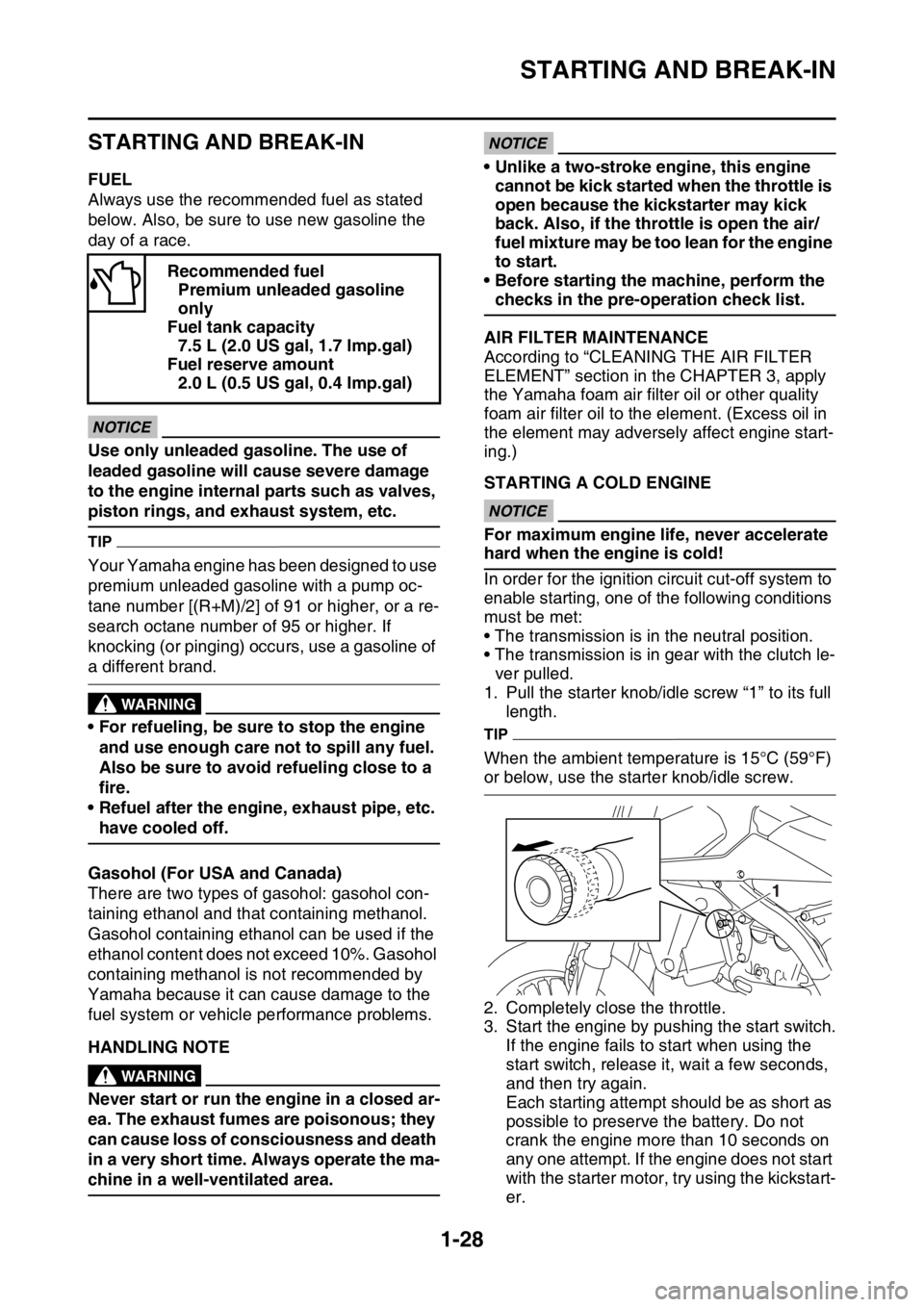
STARTING AND BREAK-IN
1-28
EAS2GC1048
STARTING AND BREAK-IN
EAS2GC1049FUEL
Always use the recommended fuel as stated
below. Also, be sure to use new gasoline the
day of a race.
ECA
NOTICE
Use only unleaded gasoline. The use of
leaded gasoline will cause severe damage
to the engine internal parts such as valves,
piston rings, and exhaust system, etc.
TIP
Your Yamaha engine has been designed to use
premium unleaded gasoline with a pump oc-
tane number [(R+M)/2] of 91 or higher, or a re-
search octane number of 95 or higher. If
knocking (or pinging) occurs, use a gasoline of
a different brand.
EWA
WARNING
• For refueling, be sure to stop the engine and use enough care not to spill any fuel.
Also be sure to avoid refueling close to a
fire.
• Refuel after the engine, exhaust pipe, etc.
have cooled off.
Gasohol (For USA and Canada)
There are two types of gasohol: gasohol con-
taining ethanol and that containing methanol.
Gasohol containing ethanol can be used if the
ethanol content does not exceed 10%. Gasohol
containing methanol is not recommended by
Yamaha because it can cause damage to the
fuel system or vehicle performance problems.
EAS2GC1050HANDLING NOTEEWA
WARNING
Never start or run the engine in a closed ar-
ea. The exhaust fumes are poisonous; they
can cause loss of consciousness and death
in a very short time. Always operate the ma-
chine in a well-ventilated area.
ECA
NOTICE
• Unlike a two-stroke engine, this engine cannot be kick started when the throttle is
open because the kickstarter may kick
back. Also, if the throttle is open the air/
fuel mixture may be too lean for the engine
to start.
• Before starting the machine, perform the
checks in the pre-operation check list.
EAS2GC1051AIR FILTER MAINTENANCE
According to “CLEANING THE AIR FILTER
ELEMENT” section in the CHAPTER 3, apply
the Yamaha foam air filter oil or other quality
foam air filter oil to the element. (Excess oil in
the element may adversely affect engine start-
ing.)
EAS2GC1052STARTING A COLD ENGINEECA
NOTICE
For maximum engine life, never accelerate
hard when the engine is cold!
In order for the ignition circuit cut-off system to
enable starting, one of the following conditions
must be met:
• The transmission is in the neutral position.
• The transmission is in gear with the clutch le- ver pulled.
1. Pull the starter knob/idle screw “1” to its full length.
TIP
When the ambient temperature is 15°C (59°F)
or below, use the starter knob/idle screw.
2. Completely close the throttle.
3. Start the engine by pushing the start switch.If the engine fails to start when using the
start switch, release it, wait a few seconds,
and then try again.
Each starting attempt should be as short as
possible to preserve the battery. Do not
crank the engine more than 10 seconds on
any one attempt. If the engine does not start
with the starter motor, try using the kickstart-
er.
Recommended fuel
Premium unleaded gasoline
only
Fuel tank capacity 7.5 L (2.0 US gal, 1.7 lmp.gal)
Fuel reserve amount 2.0 L (0.5 US gal, 0.4 Imp.gal)
1
Page 47 of 426
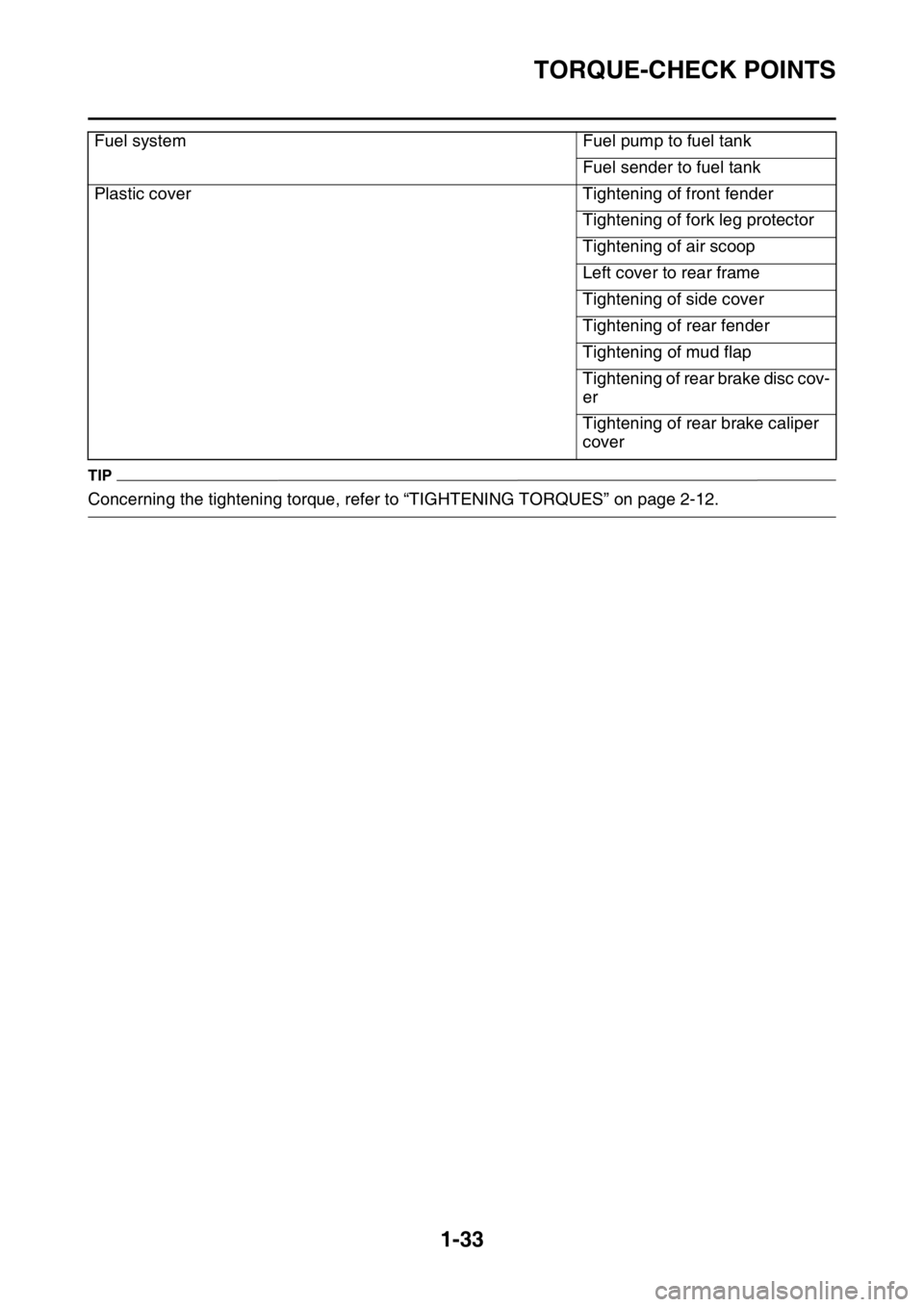
TORQUE-CHECK POINTS
1-33
TIP
Concerning the tightening torque, refer to “TIGHTENING TORQUES” on page 2-12.Fuel system Fuel pump to fuel tank
Fuel sender to fuel tank
Plastic cover Tightening of front fender Tightening of fork leg protector
Tightening of air scoop
Left cover to rear frame
Tightening of side cover
Tightening of rear fender
Tightening of mud flap
Tightening of rear brake disc cov-
er
Tightening of rear brake caliper
cover
Page 53 of 426

ENGINE SPECIFICATIONS
2-2
EAS2GC1062
ENGINE SPECIFICATIONS
EngineEngine type Liquid cooled 4-stroke, DOHC
Displacement 449 cm
3
Number of cylinders Single cylinder
Bore stroke 97.0 60.8 mm (3.82 2.39 in)
Compression ratio 12.5:1
Starting system Electric starter and kickstarter
Fuel
Recommended fuel Premium unleaded gasoline only
Fuel tank capacity 7.5 L (2.0 US gal, 1.7 Imp.gal)
Fuel reserve amount 2.0 L (0.5 US gal, 0.4 Imp.gal)
Engine oilLubrication system Wet sump
Recommended brand YAMALUBE
Type SAE 10W-40, SAE 10W-50, SAE 15W-40, SAE 20W-40 or SAE 20W-50
Recommended engine oil grade API service SG type or higher, JASO standard MA
Engine oil quantity
Quantity (disassembled) 0.95 L (1.00 US qt, 0.84 Imp.qt)
Oil change 0.67 L (0.71 US qt, 0.59 Imp.qt)
With oil filter removal 0.69 L (0.73 US qt, 0.61 Imp.qt)
Oil filterOil filter type Paper
Bypass valve opening pressure 40.0–80.0 kPa (0.40–0.80 kgf/cm
2,
5.8–11.6 psi)
Oil pump Oil pump type Trochoid
Inner-rotor-to-outer-rotor-tip clear ance 0.000–0.150 mm (0.0000–0.0059 in)
Limit 0.20 mm (0.0079 in)
Outer-rotor-to-oil-pump-housing clearance 0.13–0.18 mm (0.0051–0.0071 in)
Limit 0.24 mm (0.0094 in)
Oil-pump-housing-to -inner-and-outer-rotor
clearance 0.06–0.11 mm (0.0024–0.0043 in)
Limit 0.17 mm (0.0067 in)
Cooling system
Radiator (including all routes) 1.03 L (1.09 US qt, 0.91 Imp.qt)
Radiator capacity 0.57 L (0.60 US qt, 0.50 Imp.qt)
Radiator cap valve opening pressure 107.9–137.3 kPa (1.08–1.37 kg/cm
2,
15.6–19.9 psi)
Radiator core Width 112.6 mm (4.43 in)
Height 235.0 mm (9.25 in)
Depth 28.0 mm (1.10 in)
Water pump
Water pump type Single suction centrifugal pump
Spark plug(s)Manufacturer/model NGK/CR8E
Spark plug gap 0.7–0.8 mm (0.028–0.031 in)
Page 57 of 426
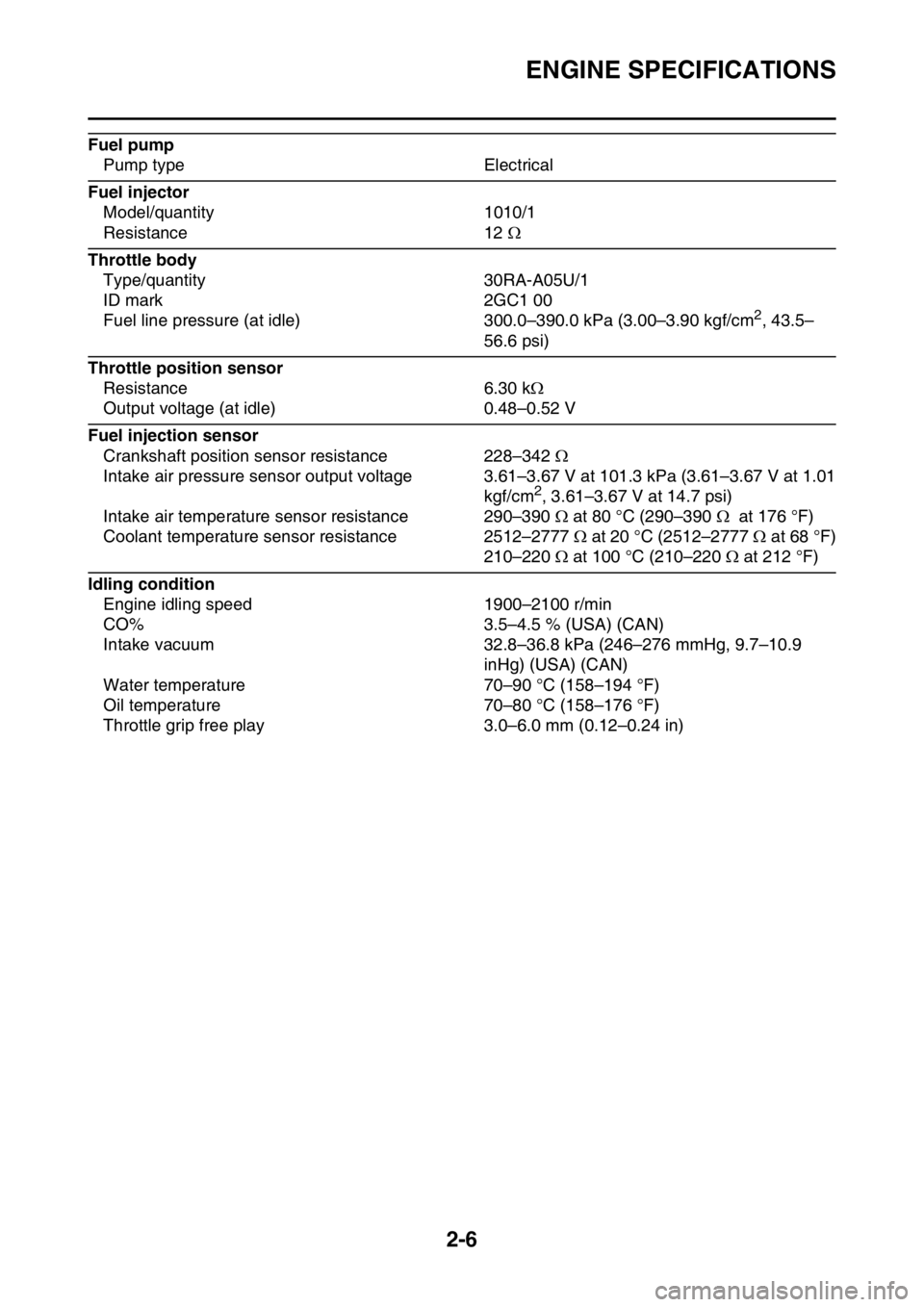
ENGINE SPECIFICATIONS
2-6
Fuel pumpPump type Electrical
Fuel injector
Model/quantity 1010/1
Resistance 12
Throttle body
Type/quantity 30RA-A05U/1
ID mark 2GC1 00
Fuel line pressure (at idle) 300.0–390.0 kPa (3.00–3.90 kgf/cm
2, 43.5–
56.6 psi)
Throttle position sensor Resistance 6.30 k
Output voltage (at idle) 0.48–0.52 V
Fuel injection sensor Crankshaft position sensor resistance 228–342
Intake air pressure sensor output voltage 3.61–3.67 V at 101.3 kPa (3.61–3.67 V at 1.01 kgf/cm
2, 3.61–3.67 V at 14.7 psi)
Intake air temperature sensor resistance 290–390 at 80 °C (290–390 at 176 °F)
Coolant temperature sensor resistance 2512–2777 at 20 °C (2512–2777 at 68 °F)
210–220 at 100 °C (210–220 at 212 °F)
Idling condition
Engine idling speed 1900–2100 r/min
CO% 3.5–4.5 % (USA) (CAN)
Intake vacuum 32.8–36.8 kPa (246–276 mmHg, 9.7–10.9 inHg) (USA) (CAN)
Water temperature 70–90 °C (158–194 °F)
Oil temperature 70–80 °C (158–176 °F)
Throttle grip free play 3.0–6.0 mm (0.12–0.24 in)
Page 70 of 426

TIGHTENING TORQUES
2-19
Drive chain tensioner bolt (lower
side)M8 1 16 Nm (1.6 m·kgf, 12 ft·lbf)
Drive chain support bolt M6 1 7 Nm (0.7 m·kgf, 5.1 ft·lbf)
Drive chain support nut M6 2 7 Nm (0.7 m·kgf, 5.1 ft·lbf)
Drive chain guide bolt M5 3 4.0 Nm (0.40 m·kgf, 2.9 ft·lbf)
Rear frame and left cover bolt M6 2 7 Nm (0.7 m·kgf, 5.1 ft·lbf)
Fuel tank bolt (front side) M6 2 7 Nm (0.7 m·kgf, 5.1 ft·lbf)
Fuel tank bolt (rear side) M6 1 9 Nm (0.9 m·kgf, 6.5 ft·lbf)
Fuel tank bracket bolt (front side) M6 4 7 Nm (0.7 m·kgf, 5.1 ft·lbf)
Fuel tank bracket bolt (rear side) M6 2 7 Nm (0.7 m·kgf, 5.1 ft·lbf)
Fuel pump bolt M5 6 4.0 Nm (0.40 m·kgf, 2.9 ft·lbf)
Fuel sender screw M6 2 4.0 Nm (0.40 m·kgf, 2.9 ft·lbf)
Fuel inlet pipe screw M5 2 3.4 Nm (0.34 m·kgf, 2.5 ft·lbf)
Fuel tank cap cover bolt M6 2 4.0 Nm (0.40 m·kgf, 2.9 ft·lbf)
Seat set bracket and fuel tank screw M6 1 7 Nm (0.7 m·kgf, 5.1 ft·lbf)
Seat bolt M8 2 22 Nm (2.2 m·kgf, 16 ft·lbf)
Left side cover bolt M6 1 7 Nm (0.7 m·kgf, 5.1 ft·lbf)
Right side cover bolt M6 2 7 Nm (0.7 m·kgf, 5.1 ft·lbf)
Frame and air scoop bolt M6 2 7 Nm (0.7 m·kgf, 5.1 ft·lbf)
Fuel tank and air scoop bolt M6 2 7 Nm (0.7 m·kgf, 5.1 ft·lbf)
Radiator guard and air scoop bolt M6 4 7 Nm (0.7 m·kgf, 5.1 ft·lbf)
Front fender bolt M6 4 10 Nm (1.0 m·kgf, 7.2 ft·lbf)
Rear fender bolt (front side) M6 4 7 Nm (0.7 m·kgf, 5.1 ft·lbf)
Rear fender bolt (rear side) M6 2 16 Nm (1.6 m·kgf, 12 ft·lbf)
Mud flap screw — 2 1.3 Nm (0.13 m·kgf, 0.94 ft·lbf)
Headlight body and headlight stay
bolt M6 2 7 Nm (0.7 m·kgf, 5.1 ft·lbf)
Multi-function meter nut M5 2 3.8 Nm (0.38 m·kgf, 2.8 ft·lbf)
Multi-function meter bracket bolt M6 1 7 Nm (0.7 m·kgf, 5.1 ft·lbf)
Front brake hose guide and head-
light stay bolt M5 1 3.8 Nm (0.38 m·kgf, 2.8 ft·lbf)
Plate 1 and front fork protector bolt M5 2 3.8 Nm (0.38 m·kgf, 2.8 ft·lbf)
Plate 2 and front fork protector
screw — 2 0.5 Nm (0.05 m·kgf, 0.36 ft·lbf)
Speed sensor lead holder and
speed sensor lead bracket bolt M6 1 7 Nm (0.7 m·kgf, 5.1 ft·lbf)
Speed sensor lead bracket and low-
er bracket bolt M6 1 13 Nm (1.3 m·kgf, 9.4 ft·lbf)
Starter relay and positive battery
lead bolt M6 1 3.5 Nm (0.35 m·kgf, 2.5 ft·lbf)
ITEM
Thread
size Q’ty TIGHTENING TORQUES Remarks
Page 91 of 426

CABLE ROUTING DIAGRAM
2-40
1. Battery negative lead
2. Fuel hose
3. Fuel pump coupler
4. Fuel pump lead
5. Resistor
6. Resistor coupler
7. Battery positive lead
8. Lean angle sensor
9. Starter motor lead
10. Radiator fan motor relay (blue tape)
11. Main relay (red tape)
12. Wire harness
13. Ground lead coupler
14. Starter relay coupler
15. Starter relay
16. Cross member
17. Diode
18. Taillight lead
19. Clamp
20. Fuel tank
21. Damper
22. Rear frame
23. Side cover 6
24. Plastic locking tie
A. After connecting the fuel pump coupler, attach the coupler cover.
B. Pass the fuel hose to the front of the battery.
C. Route the resistor lead to the outside of the leads.
D. Connect the battery positive lead to the starter re- lay terminal (in the left side of the vehicle).
E. Insert the protruding end of the wire harness into
the battery bracket hole and holder plate hole.
F. After connecting the negative lead coupler, place it on the right side of the battery.
G. Route the diode under the cross member and place it on top of the rear fender.
H. Secure the two ends of the taillight coupler with the starter motor lead.
I. Route the taillight lead so that it does not slack at
the rear of the vehicle.
J. Clamp the taillight lead and insert the clip into the rear fender. Clamp it so that the lock faces in-
ward, and then cut off the excess end.
K. Lower end of the rear frame
L. Clamp it so that the lock of the plastic locking tie
faces downward, insert the end into the rear
frame and side cover 6, and then cut off the ex-
cess end. After cutting off the excess end, make
sure that the plastic locki ng tie does not protrude
from the lower end of the rear frame.
M. Clamp it so that the lock of the plastic locking tie
faces downward, and then pass the end between
the fuel hose and rear frame.
N. Clamp the wire harness at the position of the white tape.
O. Route the battery positive lead under the cross member.
P. After connecting the battery positive lead in the direction indicated in the illustration, put the cover
on.
Page 104 of 426

PERIODIC MAINTENANCE
3-6
COOLING SYSTEMCheck coolant lev-
el and leakage
Check radiator cap
operation
Replace coolant Every two years
Inspect hoses
OUTSIDE NUTS
AND BOLTS
Retighten Refer to “STARTING AND
BREAK-IN” on page 1-28.
AIR FILTER
Clean and lubri-
cate Use Yamaha foam air filter oil
or other quality foam air filter
oil.
Replace
OIL FILTER
Replace
ENGINE GUARD Replace Breakage
FRAME Clean and inspect
FUEL TANK, FUEL
PUMP
Clean and inspect
FUEL HOSE Inspect
Replace Every four years
ITEM
After
break- in Every
race Every
third (or
500
km) Every
fifth (or
1,000 km) As re-
quired Remarks
Page 317 of 426
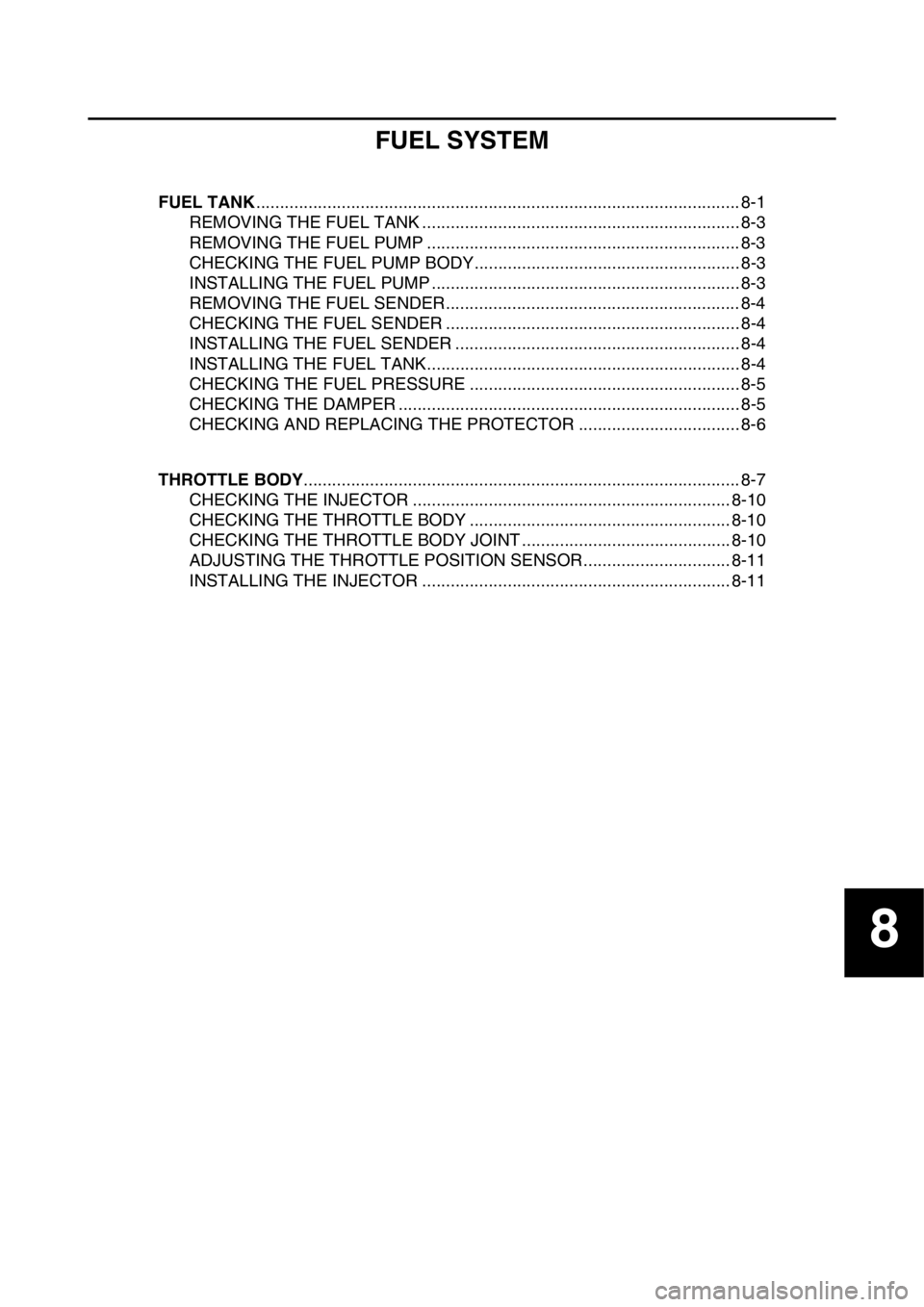
8
FUEL SYSTEM
FUEL TANK...................................................................................................... 8-1
REMOVING THE FUEL TANK ................................................................... 8-3
REMOVING THE FUEL PUMP .................................................................. 8-3
CHECKING THE FUEL PUMP BODY........................................................ 8-3
INSTALLING THE FUEL PUMP ................................................................. 8-3
REMOVING THE FUEL SENDER.............................................................. 8-4
CHECKING THE FUEL SENDER .............................................................. 8-4
INSTALLING THE FUEL SENDER ............................................................ 8-4
INSTALLING THE FUEL TANK.................................................................. 8-4
CHECKING THE FUEL PRESSURE ......................................................... 8-5
CHECKING THE DAMPER ........................................................................ 8-5
CHECKING AND REPLACING THE PROTECTOR .................................. 8-6
THROTTLE BODY ............................................................................................ 8-7
CHECKING THE INJECTOR ................................................................... 8-10
CHECKING THE THROTTLE BODY ....................................................... 8-10
CHECKING THE THROTTLE BODY JOINT ............................................ 8-10
ADJUSTING THE THROTTLE POSITION SENSOR............................... 8-11
INSTALLING THE INJECTOR ................................................................. 8-11
Page 318 of 426

FUEL TANK
8-1
EAS2GC1338
TIP
This section is intended for those who have basic knowledge and skill concerning the servicing of
Yamaha motorcycles (e.g., Yamaha dealers, serv ice engineers, etc.). Those who have little knowl-
edge and skill concerning servicing are requested not to undertake inspection, adjustment, disas-
sembly, or reassembly only by reference to this manual. It may lead to servicing trouble and
mechanical damage.
EAS2GC1339
FUEL TANK
Removing the fuel tank
OrderPart name Q’tyRemarks
Seat Refer to “GENERAL CHASSIS” on page 5-1.
Side cover (left/right)
Air scoop (left/right)
1 Fuel pump coupler 1 Disconnect.
2 Fuel hose 1 Disconnect.
3Fuel tank 1
4 Fuel pump bracket 1
5 Fuel pump 1
6 Fuel pump gasket 1
7 Fuel sender 1
4(6)
(2)
(2)
(2) (2)2
5
6
3
1
New
4.0 Nm (0.40 m kgf, 2.9 ft Ibf)T.R.
7 Nm (0.7 m kgf, 5.1 ft Ibf)T.R.
7 Nm (0.7 m kgf, 5.1 ft Ibf)T.R.
7 Nm (0.7 m kgf, 5.1 ft Ibf)T.R.
9 Nm (0.9 m kgf, 6.5 ft Ibf)T.R.
4.0 Nm (0.40 m kgf, 2.9 ft Ibf)T.R.
4.0 Nm (0.40 m kgf, 2.9 ft Ibf)T.R.
7
Page 320 of 426
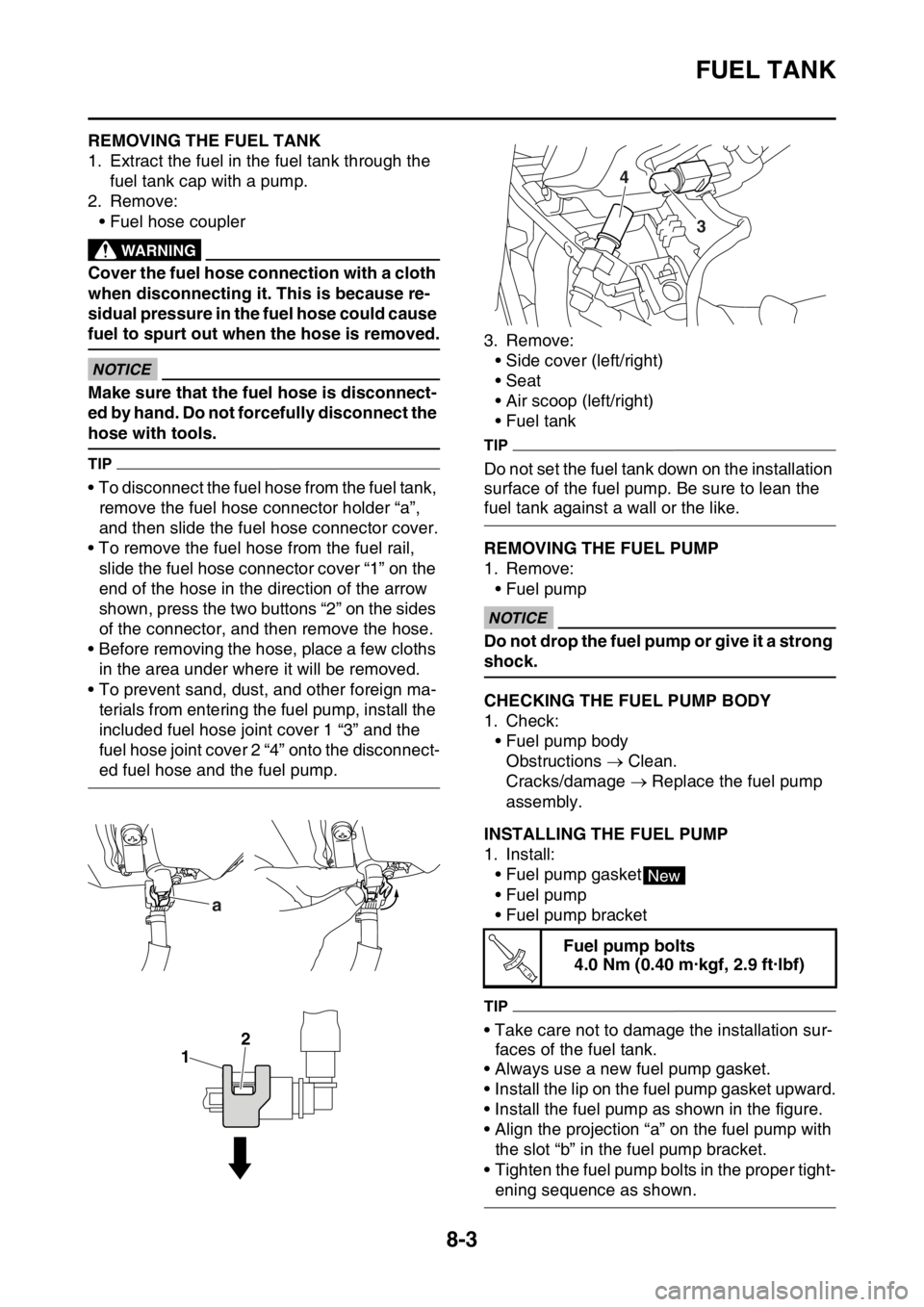
FUEL TANK
8-3
EAS2GC1340REMOVING THE FUEL TANK
1. Extract the fuel in the fuel tank through the fuel tank cap with a pump.
2. Remove:
• Fuel hose coupler
EWA
WARNING
Cover the fuel hose connection with a cloth
when disconnecting it. This is because re-
sidual pressure in the fuel hose could cause
fuel to spurt out when the hose is removed.
ECA
NOTICE
Make sure that the fuel hose is disconnect-
ed by hand. Do not forcefully disconnect the
hose with tools.
TIP
• To disconnect the fuel hose from the fuel tank, remove the fuel hose connector holder “a”,
and then slide the fuel hose connector cover.
• To remove the fuel hose from the fuel rail,
slide the fuel hose connector cover “1” on the
end of the hose in the direction of the arrow
shown, press the two buttons “2” on the sides
of the connector, and then remove the hose.
• Before removing the hose, place a few cloths in the area under where it will be removed.
• To prevent sand, dust, and other foreign ma- terials from entering the fuel pump, install the
included fuel hose joint cover 1 “3” and the
fuel hose joint cover 2 “4” onto the disconnect-
ed fuel hose and the fuel pump. 3. Remove:
• Side cover (left/right)
• Seat
• Air scoop (left/right)
• Fuel tank
TIP
Do not set the fuel tank down on the installation
surface of the fuel pump. Be sure to lean the
fuel tank against a wall or the like.
EAS2GC1341REMOVING THE FUEL PUMP
1. Remove:
• Fuel pump
ECA
NOTICE
Do not drop the fuel pump or give it a strong
shock.
EAS2GC1342CHECKING THE FUEL PUMP BODY
1. Check:• Fuel pump bodyObstructions Clean.
Cracks/damage Replace the fuel pump
assembly.
EAS2GC1343INSTALLING THE FUEL PUMP
1. Install: • Fuel pump gasket
• Fuel pump
• Fuel pump bracket
TIP
• Take care not to damage the installation sur-faces of the fuel tank.
• Always use a new fuel pump gasket.
• Install the lip on the fuel pump gasket upward.
• Install the fuel pump as shown in the figure.
• Align the projection “a” on the fuel pump with
the slot “b” in the fuel pump bracket.
• Tighten the fuel pump bolts in the proper tight-
ening sequence as shown.
a
1
2
Fuel pump bolts 4.0 Nm (0.40 m·kgf, 2.9 ft·lbf)
3
4
New
T R..